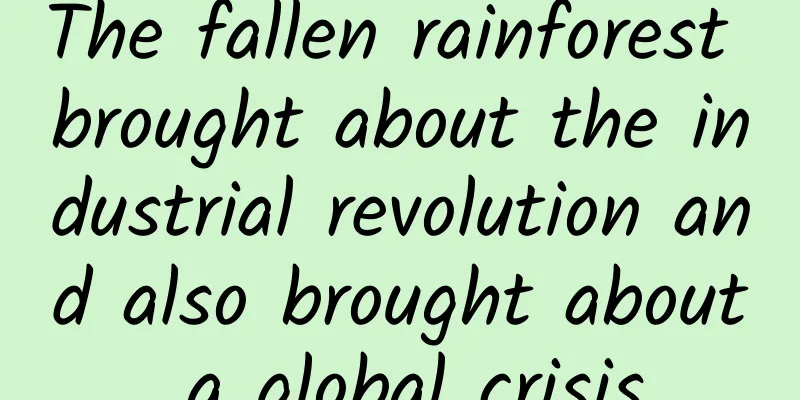The fallen rainforest brought about the industrial revolution and also brought about a global crisis

|
"Will the existence of life make this planet more suitable for life?" “Black, shiny, and with a metallic luster.” In elementary school, during a science class, the teacher asked us to observe a row of mineral specimens in glass bottles and describe them. I wrote this sentence after observing a small bottle labeled “anthracite.” Sample of anthracite coal | Leiem / Wikimedia Commons Not every science teacher has the patience to explain the course content. Fortunately, after comparing "lignite", "bituminous coal" and "anthracite", the teacher told us that the dark brown "lignite" with the most impurities is the basic form of coal. After being subjected to tremendous pressure underground, they will turn into bituminous coal with even less impurities, and then further into anthracite. “Coal was actually formed from big trees in ancient times. Those fallen trees did not disappear completely. They were buried deep underground for various reasons and turned into today’s coal.” The teacher said this calmly, but it made me very excited at the time. For the first time, I realized that there might not be a clear boundary between plants and minerals, those living and non-living things. The wheel of history, the worries of the times "Coal is black gold and the food of industry." More than 20 years later, when I typed these words that my teacher taught me in class, the 26th United Nations Climate Change Conference held in Glasgow, UK had just come to an end. This meeting, which may be crucial to the fate of mankind, finally reached an agreement. Although in the end, the Indian representative proposed to change the commitment to "phase out" coal use in the resolution document to "phase down", and the amendment was finally successful with the support of many countries, this is still the first climate agreement with a clear plan to reduce coal use. From lignite to anthracite, the carbon content gradually increases. After fractionation, coal can provide a large amount of industrial raw materials, but the main use of coal with great industrial value is still as energy fuel. Humans have been burning coal for more than 6,000 years, and there are many records about coal mining in ancient books in the East and the West. Anthracite coal mining scene | The Mebane Greeting Card Co., Wilkes-Barre, PA./Wikimedia Commons= Until 300 years ago, the rumbling sound of steam engines kicked off the first industrial revolution of mankind. The huge heat released by the burning of coal made the water in the boiler boil. The repeated expansion and cooling of the steam drove the machine, freeing humans from manual labor and eventually throwing everyone in the world on the wheel of the times. Coal has become the most important power source and continues to this day - when a stoker during the Industrial Revolution poured a full shovel of coal into the furnace door, he would never have thought that 300 years later, coal might become a curse. Anthracite coal | Randolph Black / Wikimedia Commons When coal is burned, it releases huge amounts of heat and produces carbon dioxide. Compared to the 78% nitrogen and 21% oxygen in the Earth's atmosphere, the 3 atoms of carbon dioxide can better absorb sunlight and then emit infrared radiation, making it the main contributor to the "greenhouse effect" of the atmosphere. The "greenhouse effect" itself is not a bad word. Today, the Earth can maintain a temperature suitable for many lives, which is the result of the greenhouse effect - a thin layer of atmosphere intercepts the heat of the sun, so that the water on Earth does not freeze into ice, which is the basis for the survival of life. The strong greenhouse effect of carbon dioxide also makes it one of the main factors affecting the earth's temperature. Simply put, if the concentration of carbon dioxide on the earth rises, the global average temperature will also rise; if the concentration of carbon dioxide decreases, the global average temperature will also decrease. However, the change in the global average temperature is far from being as simple as rising and falling. It brings a series of complex and chaotic processes. Some areas may become more arid, while other areas may experience frequent floods and meteorological disasters. Pests and diseases will become more difficult to control, and agricultural production will also be greatly affected. Greenhouse effect | Robert A. Rohde / Wikimedia Commons This is why scientists are extremely concerned about the concentration of carbon dioxide in the atmosphere: human survival and development require stable climate conditions, and the stability of carbon dioxide content is very important. However, in the past 20 years of monitoring, the concentration of carbon dioxide has climbed to a new level almost every year, recently reaching 420ppm. According to model estimates, this is also the highest in the past 4.5 million years, and summer temperatures in various places have frequently set new records. Most of this extra carbon dioxide is caused by past human activities. Developed countries are primarily responsible for historical carbon emissions, and emerging countries will inevitably emit more carbon dioxide into the atmosphere in the future for the sake of people's livelihood development. Concerns have led scientists to speak out, and far-sighted politicians have promoted international cooperation and negotiations to strive to control carbon dioxide concentrations within a certain range. Factory fueled by coal | cogdogblog / Wikimedia Commons This will be a difficult game, especially for countries where coal still dominates the energy sector. According to the BP Statistical Review of World Energy released by BP, in 2020, global coal-fired power generation still accounted for more than 35%, while others such as natural gas accounted for about 25%, hydropower accounted for 16%, nuclear power accounted for 10%, and renewable energy such as solar and wind power accounted for 12%. In Asia, the proportion of coal energy is even higher, which means that the achievement of the Glasgow Climate Agreement will still put tremendous pressure on energy development in India and other countries, and the dispute has not stopped to this day. Coal – End of Life Cycle Where does this coal, which has attracted the world's attention and changed the modern human world several times, come from? All major changes will leave traces in the strata. This is another ancient story that happened 350 million years ago. The earliest forests on Earth were born in the Devonian period after plants landed. The first terrestrial plants had no supporting structure, and some plants were able to synthesize cellulose with a certain strength, but most plants remained low and close to the water to avoid dying of thirst. Tens of millions of years later, a biochemical pathway evolved in plant cells, producing a substance that had never appeared on Earth - lignin. These lignin molecules are composed of multiple benzene rings, which are accumulated around the cells of plants, interconnected and squeezed to form the earliest wood on Earth. The main function of hard lignin for plants is support, and then to form conductive tissues to transport water and nutrients, so that the plant body can grow tall. Plants that have evolved this pathway can obtain more sufficient light and live in drier environments. They quickly replaced the low life around them, and their descendants became taller - in this "involution" 350 million years ago, perhaps the most magnificent forest in geological history was born. Fossilized insect wings found in British coal seams | Herbert Bolton / Biodiversity Heritage Library They are completely different from today's forest trees, and are closely related to today's lycopods and horsetails in ferns. Paleobotanists have given them names such as Calamites, Sigillaria, and Lepidodendron based on the remaining fossil traces. Although most of today's lycopods and horsetails are only a few dozen centimeters tall, their ancient relatives easily reached 30 to 40 meters tall. This is the rainforest of the Carboniferous period. During this period, forest photosynthesis once raised the earth's oxygen content to more than 30%. The high concentration of oxygen also made the insects of the same period much larger than today, and giant dragonflies of several feet long roamed in the rainforest. But the collapse of this magnificent rainforest may come from the rainforest itself. Lignin was too advanced for the life on Earth at that time. In the early days of the tall forests, the fungi on Earth, which served as decomposers, probably had not yet produced enzymes that could decompose them. Etching depicting a Carboniferous forest landscape from the Carboniferous period | Bibliographisches Institut - Meyers Konversationslexikon This is a terrible one-way street. More and more carbon is locked up in the bodies of dead plants. After tens of millions of years of lignin accumulation, the carbon dioxide on Earth fell below the critical point during the Kasimovian period of the Carboniferous period about 305 million years ago. The weakening of the greenhouse effect led to a global cooling for millions of years. Ice and snow once again covered most of the world, and most of the Carboniferous forests disappeared. This is called the "Carboniferous rainforest collapse event." When fungi finally acquired the ability to degrade lignin, carbon returned to the atmosphere in the form of carbon dioxide and the earth resumed warming. Millions of years later, a large number of terrestrial plants, insects and amphibians became extinct in the process. The tree shells that existed before fungi were able to decompose wood became coal in geological changes, and changed the face of the earth in another form 300 million years later. Illustration of fossil plants in British coal seams | Internet Archive Book Images / Flickr Although the discovery of fungal microfossils in the Carboniferous period in recent years has provided more details of this story, the fact is that after the Carboniferous-Permian period, fungi around the world became the main force in degrading forest lignin, and coal seams in the strata after the Permian period were no longer as extensive as in the Carboniferous period. The Carboniferous forests left coal, sealed it underground, and ended in a world with a colder climate. Throughout the history of life on Earth, these phenomena are not uncommon. 3.7 billion years ago, the initial chemical synthesis and photosynthesis of some life on Earth may have drastically changed the composition of the Earth's atmosphere, thereby dragging all life on Earth into an almost irreversible situation. American paleontologist Peter Ward even created a "Medea hypothesis" to oppose the tender "Gaia hypothesis" proposed by British scholar James Lovelock in the 1970s - life is likely to end with life. A group of coal miners gathered around a fossilized tree root in 1918 | J. Horgan, Jr. / nationalgeographic So, as we mine coal and other fossil fuels and release carbon dioxide back into the atmosphere, one can't help but wonder if this is the end of a new cycle of life on Earth? I can only believe that humans should have higher wisdom to put an end to this problem. |
Recommend
How do octopuses and fish carry out "cross-border hunting cooperation"?
In nature, we often see animals of the same speci...
10,000 words of dry goods, an analysis of the considerations for setting up games at the user selection level
PART1 I will never forget Boyd. May he rest in pe...
Huang Hongsheng, who denounced Xu Jiayin, awakened his "car-making bloodline" in prison and now sells 3,600 cars a month
"Xu Jiayin left debts to society, his wife a...
Play with Android nested scrolling
In the process of Android UI development, we ofte...
According to the access rules of Tik Tok information flow, these industries are strictly prohibited from advertising!
In the past year, the three words " short vi...
High temperatures in the south and rain in the north. How to prevent "July down and August up"?
On July 28, the Central Meteorological Observator...
How romantic is electromagnetism? Let's take a look at the "love and hate" between superconductivity and spin waves
Author: Luo Huiqian Institute of Physics, Chinese...
Operational skills and ideas for playing short videos
In recent years, short videos have occupied the l...
Mount Everest has grown taller? Uncovering the secrets behind the river's invasion
Author: Duan Yuechu and Huang Yanhong On our plan...
Convolutional neural networks cannot process "graph" structured data? This article tells you the answer
This article introduces a paper about the applica...
"Transparent Earth" black technology: Using seismic waves to perform CT scans on the Earth
Major events on Earth are often related to its in...
Tesla factory is coming! The Chinese factory site is expected to be announced this year
The development momentum of new energy vehicles i...
The Ministry of Industry and Information Technology has issued a new standard, with fuel consumption of less than 3.3L per 100 kilometers. Is the deadline for fuel-powered vehicles less than two years away?
The Chengdu Auto Show is underway, and compared w...
Electric Technology Car News: Changan CS55 released, can the shortcomings of the independent SUV market be made up?
With the continuous efforts of domestic automaker...
Osmanthus fragrans, Osmanthus sinensis, or Osmanthus fragrans? They all refer to the same plant!
"The plump ears of rice bring happiness to t...









